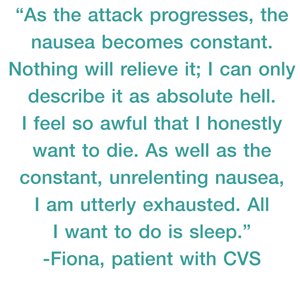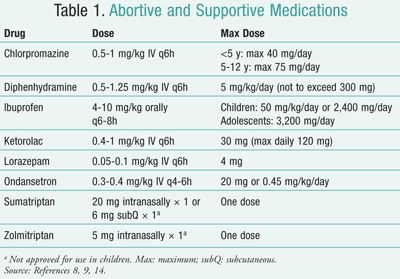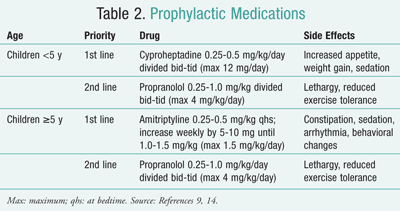US Pharm. 2010;35(1):HS20-HS24.
Cyclic vomiting syndrome (CVS) is a functional brain-gut disorder characterized by recurrent severe prolonged episodes of nausea and vomiting in otherwise healthy people.1-3 These episodes can be excruciating and last for days. They are frightening for the patient and family and may lead to serious complications.
Clinical Features
CVS occurs in all age groups, although it is more common in children. It typically presents around the age of 3 to 5 years. On average, children have approximately 12 episodes per year, each lasting 12 to 24 hours.3-7 CVS consists of four phases, which are described below.
Symptom-Free Interval: This is the period between episodes. It can last from a few weeks to several months, and during this time, the child has no symptoms.1,8
Prodrome: This phase is marked by nausea, with or without abdominal pain, and anorexia before an episode of vomiting. At this point, it may be possible to prevent an episode using abortive medications. This must be done quickly, as this phase may last only a few minutes and rarely lasts more than a couple of hours. In some children, this phase is skipped entirely and the child wakes up in the morning vomiting.1,8
Vomiting: This phase usually begins very early in the morning. In addition to the extreme nausea of prodrome, the child begins vomiting and continues to vomit or heave every 5 to 10 minutes. During this period, the child cannot tolerate food, drink, or medication by mouth, so treatment must be given intravenously.1,8 However, some children may drink water compulsively, as this sometimes makes the vomiting less uncomfortable. This should be allowed.6,8 The vomiting episodes usually last for 1 to 3 days.1,7,8
Recovery: The recovery phase begins with the disappearance of nausea and vomiting and lasts until the child resumes normal appetite and activity. Some children may be able to return to eating within a couple of hours, but many will take a few days to return to a regular diet and get their energy back.1,8,9
CVS follows a typical pattern for each child, which means that each episode is similar to previous ones, starting at the same time of day, lasting the same length of time, and occurring with the same symptoms and level of intensity. Attacks can be so relentless that a child has to stay in bed for days, unable to go to school or participate in family activities.10 Complications of CVS include severe dehydration, electrolyte imbalances, hematemesis, Mallory-Weiss tear of the esophagus, aspiration, and hypovolemic shock.1,6

Epidemiology
Although it is difficult to determine the exact prevalence of CVS, it is estimated to be somewhere between 0.3% and 2.2% of children.11 The condition also affects females more often than males, with an average age of onset of 4 years.10,11 CVS has been described in all ethnicities, but it is most common among Caucasians.6,7,11 CVS results in 24 missed school days and an annualized cost of care of $17,035.11
Diagnosis
CVS is often misdiagnosed as food poisoning or acute viral gastroenteritis. Patients are often seen by a variety of health care providers—in the emergency room, urgent care clinics, and pediatricians’ offices—so the cyclic pattern goes unnoticed until a parent becomes concerned. A proper diagnosis is essential for patients to gain control over their disease and prevent attacks.12
No blood tests or imaging studies are available to establish a diagnosis of CVS. Other disorders must be ruled out, and a pattern to the vomiting must be identified. For a diagnosis of CVS, a child must meet all of the following criteria7,9:
• A minimum of five attacks in any period, or at least three attacks in 6 months;
• Episodes of vomiting lasting between 1 hour and 10 days and occurring at least 1 week apart;
• Follows a typical pattern in the individual patient;
• Vomiting at least four times/hour for at least 1 hour;
• Normal health between episodes; and
• Symptoms not attributed to another disorder.
Abdominal pain, diarrhea, fever, dizziness, and sensitivity to light often accompany the vomiting during acute episodes.6,11
Differential diagnosis should include gastrointestinal (GI) abnormalities, central nervous system disorders, kidney stones or gallstones, metabolic-endocrine disorders, appendicitis, and inflammatory bowel disease.7,9,11 In children with any of the following, further diagnostic testing is warranted: bilious vomiting, abdominal tenderness, hematemesis, neurologic abnormalities, progressively worsening episodes, or attacks triggered by illness, fasting, or high-protein meals.7,9
Treatment of Acute Episodes
Currently, there is no standard evidence-based treatment for CVS. Very few trials have been conducted to study treatments for CVS, so recommendations largely are based on expert opinion.9
Prodrome Phase: Some children go through a stage lasting minutes to days where warning symptoms are present before the vomiting begins. This may involve extreme nausea with or without abdominal pain, lethargy, pallor, and anorexia. Sometimes, during the prodrome phase, it is possible to stop an episode from happening. The child should be placed in a dark, quiet room to decrease stimulation and should try to sleep.6 Diphenhydramine or lorazepam may be used for sedation, ondansetron for nausea, or ibuprofen for abdominal or epigastric pain to decrease symptoms and prevent progression to vomiting.8
Vomiting Phase: Immediate treatment of vomiting attacks is crucial, since the physical stress of the episode predisposes the patient to more vomiting and perpetuates the cycle. Once a vomiting episode begins, treatment usually requires the person to stay in bed and sleep in a dark, quiet room. Attacks often progress to severe nausea and vomiting requiring hospitalization.6
Abortive Treatment: First, the patient should be started on IV fluids, typically 10% dextrose and 0.45% normal saline with potassium chloride and an H2 blocker or proton pump inhibitor for fluid maintenance.8,9 In children above 12 years of age, antimigraine drugs such as sumatriptan may be prescribed to stop symptoms.9,13 These drugs have not been FDA approved for use in children and adolescents, but have been used. Sumatriptan can be administered intranasally or subcutaneously to circumvent medication loss due to vomiting. Zolmitriptan also comes in a nasal form. These drugs will either stop the attack within an hour or 2 or will not work at all, and therefore should not be dosed repeatedly.9,13 In children less than 12 years old, an attempt should be made to terminate the episode by giving 0.05 to 0.1 mg/kg IV lorazepam (maximum [max] 4 mg) and 0.3 to 0.4 mg/kg IV ondansetron (max 0.45 mg/kg/day) . In either case, if the nausea clears, the patient should be given a 4- to 8-mg dose of ondansetron orally and sent home after demonstrating a tolerance for food and drink. If the nausea does not clear, or if it clears but returns, supportive care must be relied upon.8,9,14
Supportive Treatment: When an episode cannot be stopped, the best way to provide relief to the patient is by sedation. Sleep gives the child a break from the discomfort, and since the vomiting is not due to a physical GI problem, it will stop once the patient is asleep. It is believed that the brain is in some way responsible for the vomiting, although the mechanism is still unknown.7,8 The preferred regimen for sedation is a combination of chlorpromazine 0.5 to 1 mg/kg (<5 years: max 40 mg/day; 5-12 years: max 75 mg/day) and diphenhydramine 0.5 to 1.25 mg/kg (max 5 mg/kg/day, not to exceed 300 mg) in 50 mL of normal saline infused over 15 minutes. This can be repeated every 6 hours as needed for wakefulness and nausea and may be required for several days depending on the patient.8,9,14
A summary of abortive and supportive medications is given in TABLE 1.

Recovery Phase: When the vomiting phase ends and the nausea subsides, patients may resume eating and drinking as soon as they are ready and as tolerated. Some will return immediately to a regular diet, while others will need a slow advancement from clear liquids to solid foods. The patient should be allowed to determine the pace. Prophylactic medications should be resumed as soon as possible.8,9
Prevention
Prevention of attacks centers around two strategies—trigger avoidance and prophylactic medication. By keeping a vomiting diary, most families are able to identify triggers that precipitate vomiting episodes and thereby avoid them in the future.9 The most common trigger for children is positive excitement around events like birthdays, holidays, and vacations. While these events do not necessarily need to be avoided, every attempt should be made to downplay the excitement surrounding them and keep a calm environment. Physical stress is another contributing factor. Infection is a common cause, as are strenuous exercise and lack of sleep. Specific triggers can include menses, motion sickness, or certain foods (e.g., chocolate, cheese, monosodium glutamate).1,6,9 Some adolescents may try to self-medicate for nausea with marijuana, but this can actually worsen CVS.9 Psychological stress can be a trigger, including anxiety from fear of the next attack. It is sometimes helpful to seek psychological counseling and stress reduction techniques for some children.6,15
In children with frequent attacks (more than 1 or 2 per month), repeated hospitalizations, or poor response to abortive treatment, prophylactic drug treatment may be initiated (TABLE 2).8,9,16 In young children (<5 years), the drug of choice is cyproheptadine, and an alternative is propranolol.9 Cyproheptadine has been shown to cause some weight gain in this population due to increased appetite, but this does not typically require discontinuation of the medication and may be beneficial in underweight patients.16 In children 5 years and older, amitriptyline is first-line treatment, followed by propranolol. Other drugs that are sometimes used, but lack supporting evidence, include anticonvulsants, erythromycin, L-carnitine, and coenzyme Q10.9

CVS and Migraine
CVS was linked to migraine headaches as early as 1904.17 The relationship between migraine and CVS is still unclear, but experts believe the two conditions are related. Both CVS and migraines are characterized by a sudden onset of severe symptoms and followed by symptom-free intervals between attacks. Migraine and CVS share many of the same triggers, such as stress or certain foods. The majority of children with CVS—about 80%—are classified as having migraine-associated CVS, defined as patients with family history of migraine or progression to migraine headaches later in life.18 CVS often resolves with puberty, at which point the child starts to have migraines.11
Differences exist between migraine-associated and nonmigraine CVS. Children with migraine-associated CVS tend to have less severe episodes of vomiting. They experience shorter episodes with fewer attacks of vomiting but have more frequent episodes. They are more likely to have accompanying abdominal pain, headache, and photophobia than children with nonmigraine CVS. They are also more likely to identify triggers such as stress, exertion, and motion sickness. Patients with migraine-associated CVS have a better response to abortive treatment with triptans and to prophylaxis with propranolol.17
Why do only some affected children have CVS associated with migraines? It may be that there is an overlying cause of both CVS and migraines, and some children escape the second syndrome.12,19 New theories suggest that CVS may be related to mitochondrial dysfunction. It has been hypothesized that in times of physical or psychological stress when the body requires more energy, inadequate cellular energy production leads to metabolic crisis. This interferes with neurons, which also have high-energy needs, leading to cyclic vomiting or migraine headache.12,19-21 It is also possible that migraine-associated and nonmigraine CVS are two entirely different disorders with different pathophysiologies.17 In addition to mitochondrial dysfunction, oversecretion of corticotropin and anti-diuretic hormone and autonomic dysfunction have also been proposed as causes for CVS.11,12,22 Until we have a better understanding of the cause of these disorders, it will be impossible to characterize the relationship between migraine and CVS or to speculate as to why some children progress to migraines while others seem to simply outgrow the condition.
Conclusion
It is clear that CVS is extremely distressing to those who suffer from the condition. Attacks are agonizing, exhausting, and disruptive to the lives of these children. Although the cause of this disorder is still unknown, there is agreement on care of the patient. With an early diagnosis, timely abortive treatment, and appropriate prevention strategies, the suffering of children with CVS can be greatly reduced. Hopefully, future research can offer a better understanding of CVS and help those who suffer from it to lead more normal lives.
REFERENCES
1. Cyclic vomiting syndrome. National Digestive Diseases Information Clearinghouse. Updated December 2008. http://digestive.niddk.nih.
2. Cyclic Vomiting Syndrome Association. September 2009. www.cvsaonline.org. Accessed September 17, 2009.
3. Wyllie R. Clinical manifestations of gastrointestinal disease. In: Kliegman RM, Behrman RE, Jenson HB, Stanton B, eds. Nelson Textbook of Pediatrics. 18th ed. Philadelphia, PA: Saunders; 2007:1523-1525.
4. Fitzpatrick E, Bourke B, Drumm B, Rowland M. The incidence of cyclic vomiting syndrome in children: population-based study. Am J Gastroenterol. 2008;103:991-996.
5. Fleisher DR, Matar M. The cyclic vomiting syndrome: a report of 71 cases and literature review. J Pediatr Gastroenterol Nutr. 1993;7:361-399.
6. Pareek N, Fleisher DR, Abell T. Cyclic vomiting syndrome: what a gastroenterologist needs to know. Am J Gastroenterol. 2007;102:2832-2840.
7. Venkatasubramani N, Venkatesan T, Li BU. Extreme emesis: cyclic vomiting syndrome. Pract Gastroenterol. 2007;31:21-34.
8. Fleisher DR. Empiric guidelines for the management of cyclic vomiting syndrome. July 2008. www.ch.missouri.edu/fleisher/
9. Li BU, LeFevre F, Chelimsky GG, et al. North American Society for Pediatric Gastroenterology, Hepatology, and Nutrition consensus statement on the diagnosis and management of cyclic vomiting syndrome. J Pediatr Gastroenterol Nutr. 2008;47:379-393.
10. Withers GD, Silburn SR, Forbes DA. Precipitants and aetiology of cyclic vomiting syndrome. Acta Paediatrica. 1998;87:272-277.
11. Li BU, Misiewicz L. Cyclic vomiting syndrome: a brain-gut disorder. Gastroenterol Clin North Am.
12. Li BU, Howard JC. New hope for children with CVS. Contemp Pediatr. 2002;19:121-130.
13. Benson J, Zorn S, Book L. Sumatriptan in the treatment of cyclic vomiting. Ann Pharmacother.
14. Clinical Pharmacology Web site [subscription required]. www.clinicalpharmacology-ip. 2003;32:997-1019. 1995;29:997.
15. McRonald FE, Fleisher DR. Anticipatory nausea in cyclic vomiting. BMC Pediatr. 2005;5:3.
16. Andersen JM, Sugerman KS, Lockhart JR, Weinberg WA. Effective prophylactic therapy for cyclic vomiting syndrome in children using amitriptyline or cyproheptadine. Pediatrics. 1997;100:977-981.
17. Li BU, Murray RD, Heitlinger LA, et al. Is cyclic vomiting syndrome related to migraine? J Pediatr. 1999;134:567-572
18. Abu-Arafeh I, Russell G. Cyclical vomiting syndrome in children: a population-based study. J Pediatr Gastroenterol Nutr. 1995;21:454-458.
19. Li BU, Balint JP. Cyclic vomiting syndrome: evolution in our understanding of a brain-gut disorder. Adv Pediatr. 2000;47:117-160.
20. Boles R, Adams K, Li BU. Maternal inheritance in cyclic vomiting syndrome. Am J Med Genet A.
2005;133:71-77.
21. Boles RG, Chun N, Senadheera D, Wong LJ. Cyclic vomiting syndrome and mitochondrial DNA mutations. Lancet. 1997;350:1299-1300.
22. Chelimsky TC, Chelimsky GG. Autonomic abnormalities in cyclic vomiting syndrome. J Pediatr Gastroenterol Nutr. 2007;44:326-330.
To comment on this article, contact rdavidson@uspharmacist.com.





